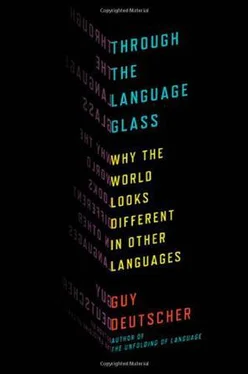What is more, Gladstone’s fundamental insight that the opposition between bright and dark was the primary basis for the Homeric color system could also stand virtually unimproved at the cutting edge of current thinking on the development of color vocabulary. Not that anyone would admit nowadays that the insight is Gladstone’s, mind you. In modern accounts, the idea that languages shift the emphasis from a brightness-based system toward hue is presented as a shiny new and ultramodern theory. But while this modern theory is far more impressive than the old one in the complexity of its terminology, in actual content it offers little that cannot be found in Gladstone’s original analysis.
But perhaps the greatest irony in the whole story is that even the seemingly infantile evolutionary model that Gladstone invoked at the very beginning of the color debate was actually spot-on. The Lamarckian evolution-through-stretching mechanism is a perfect way to explain the changes between Homer’s time and ours-if only we overlook one little detail, namely that Gladstone thought he was describing biological developments. For while the Lamarckian model, whereby the acquired aptitudes of one generation may become the inherited and inborn aptitudes of another, is a ridiculous way to explain anatomical changes, it is a perfectly sensible way to understand cultural evolution. In biology, characteristics acquired within the lifetime of an individual are not passed on to the offspring, so even if exercising the eye could improve one’s own sensitivity to colors, the improvement would not be genetically transmitted to the next generation. But the Lamarckian model does fit perfectly with the reality of cultural developments. If one generation exerts its tongue and “stretches” the language to create a new conventional name for a color, then the children will indeed “inherit” this feature when they learn the language of their parents.
So Gladstone’s assertion that the developments in the vocabulary of color involved the “progressive education” of mankind is in actual fact entirely correct, and so is his belief that “Homer’s organ” still needed to be trained in the discrimination of colors. It is only that Gladstone did not realize which human faculty underwent this progressive education and which organ it was that needed to be trained. And it is exactly in clarifying this troublesome question, in telling apart the eye from the tongue, education from anatomy, culture from nature, that substantial headway has been made in the century and a half-long debate. It is here that our view has sharpened since the culture blindness of Gladstone in 1858, of Geiger in 1869, of Magnus in 1878, and of Rivers in 1903, but also since the nature blindness of Leonard Bloomfield in 1933 (languages mark off color boundaries “quite arbitrarily”) and of Verne Ray in 1953 (“there is no such thing as a ‘natural’ division of the spectrum”), and even since the culture myopia of Berlin and Kay in 1969.
BEYOND COLOR
The fighting over the rainbow may have been fiercer and more prolonged than over any other concepts, but the insights that have emerged from the debate can be applied with equal benefit elsewhere in language. The framework of freedom within constraints, which I suggested above, provides the best way to grasp culture’s role in shaping the concepts of language more generally, and even its grammatical system.
Different cultures certainly are not at liberty to carve up the world entirely at whim, as they are bound by the constraints set by nature-both the nature of the human brain and the nature of the world outside. The more decisive nature has been in staking out its boundaries, the less leeway there is for culture. With cats and dogs and birds and roses, for instance, culture hardly has any freedom of expression at all. We can be quite certain that in any society where there are birds and roses, there will be words that correspond to our “bird” and “rose,” and there will not be words that correspond to the Ziftish “rird” and “bose.” Even if one tried to construct an artificial language brimful of unnatural Ziftish concepts, it is not clear that children would be able learn these. For obvious humanitarian reasons, the experiment has not been conducted, but if ever anyone is cruel enough to raise young children on a monolingual diet of rirds and boses, dats and cogs, steaves and lones, the result will probably be that the hapless children will fail to learn these concepts “correctly” and instead impose an “incorrect” interpretation with more sensible and more natural meanings, which will correspond to our birds and roses, cats and dogs, leaves and stones.
On the other hand, when nature has shown even the slightest dithering or fuzziness in marking its boundaries, different cultures have far more sway over the division of concepts than anyone exposed only to the conventions of one society would imagine. Of course, concepts must be based on some sensible logic and internal coherence if they are to be both useful and learnable. But within these limits, there are still many ways of dissecting the world that are perfectly sensible, perfectly learnable by children, perfectly suitable for the communicative needs of the speakers-and yet totally different from what we are used to.
The field of color made it glaringly obvious that the unfamiliar may not always be unnatural. A language in which yellow, light green, and light blue are treated as shades of one color, for instance, may seem to us almost incomprehensibly alien, but this division makes perfect sense within a system whose primary emphasis is on brightness rather than hue and where the main prismatic color to be set apart is red, so that all bright hues that have no tinge of redness naturally belong to the same concept.
But there are many other examples of the discrepancy between what is unnatural and what is merely unfamiliar. We will encounter one striking but little-known case in a later chapter: the concepts used to describe space and spatial relations. A more famous example is kinship terms. The language of the Yanomamö Indians in Brazil, for instance, appears to us incomprehensibly hazy, because it lumps together relatives of entirely different kinds under one concept. Using one and the same term, šoriw∂ , for both cousins and brothers-in-law may already seem rather peculiar. But this is nothing compared with the unification of brothers and certain cousins: the Yanomamö term ε iw∂ makes no distinctions between one’s own brothers and the sons of a paternal uncle or of a maternal aunt! On the other hand, the Yanomamö would consider English unbearably vague in having just one term, “cousin,” which lumps together no less than four distinct type of relatives: amiw∂ (daughter of a paternal uncle or of a maternal aunt), ε iw∂ (son of paternal uncle or of maternal aunt), suw∂biy∂ (daughter of maternal uncle or of paternal aunt), and šoriw∂ (son of maternal uncle or of paternal aunt). There are even weirder systems of kinship terms, such as the one that anthropologists call the Crow system, in which the same concept is used for one’s own father and for some of one’s cousins (the sons of a paternal aunt). All these ways of dividing up one’s relatives have their own internal logic and coherence, but they nevertheless diverge radically from the categories that we find natural.


The freedom of culture is even more pronounced in the realm of grammar, since grammatical structures are by nature more abstract and, as we have seen, nature’s hold loosens considerably in the realms of abstraction. One striking aspect of the grammatical system that varies even among mainstream languages is the order of words. Japanese and Turkish, for instance, arrange words and grammatical elements in a way that seems to us perversely back to front. In The Unfolding of Language , I discussed examples such as the Turkish sentence Padi ah vezir-ini ordular-ι -nι n ba -ι -na getirdi , where a literal translation of each element-“Sultan vizier his troops his of head their to brought”-is almost as unenlightening to an English speaker as the Turkish itself. But for a Turkish speaker encountering English for the first time, the English arrangement-“the Sultan brought his vizier to the head of the troops”-would appear just as peculiar.
Читать дальше













